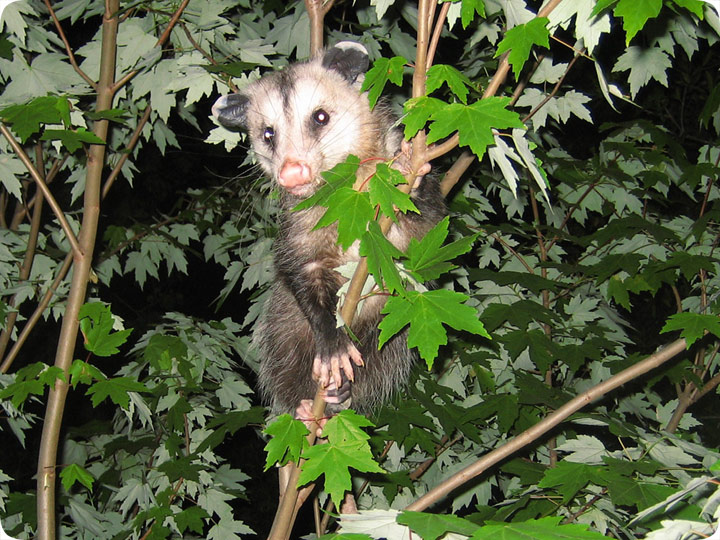-
info@aaanimalcontrol.com
Call us for help in your town
Humane Wildlife Education
Mystery Animal In a Tree

04.21.2005 - I have a very strange customer. Her name is Hilda. She calls me all the time. She won't leave me alone. She has problems. She hears things. She sees things. Then it becomes my problem, because I hear my phone and I see that it's her number calling me
yet again so that she can talk my ear off about her latest wildlife problems.
"David, David! This is Hilda! I am hearing them again, they are keeping me awake, they are making so much noise, David, you must come help me David!". Except that her voice is much more annoying than the voice you used in your own head when you read that last sentence. That's one
of the problems with text - everything you read comes across in your own nice personal voice, the one you've no doubt grown accustomed to over the years. But no, if you heard the real Hilda, you'd have winced by the second "David" out of her mouth.
Here's the problem that Hilda keeps having: she not only hears mystery noises in her attic - months of trapping and tracking and all sort of inspection and test have
conclusively revealed that she has no animals in her attic - but she also SEES mystery animals. Her bedroom is adjacent to a streetlamp, between which is a tree. So
she sees the shadow of the tree projected on the wall of her bedroom at night. She looks at this shadow, and she sees things. Oh, how she sees things, and oh how
she calls me every few days to tell me what she sees. Most of the time, she sees normal-looking critters. However, she recently saw something that bothered me.
The phone call went as such: "David David! Last night in the tree, I see a little man! It walk up the tree, a little 2-foot man, with hands and arms, it's in
the tree, David you must help me!" So I went to her house and I investigated. I looked at the shadows on the wall. I described the wildlife of Florida.
I eventually learned that this little man had a long skinny tail that was curved at the end. I waited until the shadow re-appeared and Hilda said, "There it is! The
little man!" I shone my light on the tree and took this photo. Hilda is not convinced that this is actually the shadow she saw. She will call me again.
Do it yourself: Visit my How To Trap Animals Yourself page for tips and advice.
Get professional help: Visit my Nationwide Pro Directory of wildlife removal experts.
For more wildlife stories, click my Wildlife Blog
or click my below banner to hire a local trapper.
So, you've found an animal in a tree? Well, that's not something new. While birds are popularly known to perch and build their nests on trees, there are other animals that you won't believe can make trees their homes. Tree hollows provide a warm and comfortable shelter liked by many wild animals.
Many animals such as raccoons spend their time in trees while sleeping, eating, and just playing around. And that's why it could be reasonable to find a raccoon in a tree. When the opportune time comes, these tree-huggers get to the ground to hunt for food and water. The critters have specialized adaptation such as agile hands that enables them to grasp firmly on trees.
Even though several animals like koalas, sloths, possums, squirrels, monkeys, and others are excellent tree-huggers, a raccoon could be at par with them. With its ability to climb a tree and come down in either orientation, this critter can live almost anywhere, including trees, the attic, the porch, and other dark and dingy places. These cute and cuddly critters have friendly faces but are very destructive and can ruin your crops and damage your property within no time.
A raccoon is an excellent climber, making tree hollows its alternative den when it can't get a better place to hide and give birth. The critter in the wild prefers making a nest and sleeping in tree hollows or a hollow part of a fallen log. A mother raccoon who is raising her children often makes her nest in a high tree hollow to keep her pups away from predators.
Why would a raccoon prefer living in a tree? Well, the answer is pretty straightforward. Raccoons climb or live in trees for several reasons. But there are a few main reasons why you would see this critter on a tree. Below are the reasons;
- To escape from danger or predators
- To gain access to your roof or attic
- To nest and raise their young ones
Life on trees provides a challenge to raccoons and other arboreal animals. However, they have specialized adaptions that enables them to move from tree to tree, take care of their young ones, and gather food. Below are raccoon's main features that make it survive life on a tree.
- Gripping feet- Raccoons have strong claws and flexible ankle joints that enable them to grip the tree and swiftly move up and down. Low center of gravity- Unlike most land animals that swing from side to side, raccoons have a low center of gravity that minimizes their chances of falling off the tree while moving up and down.




















